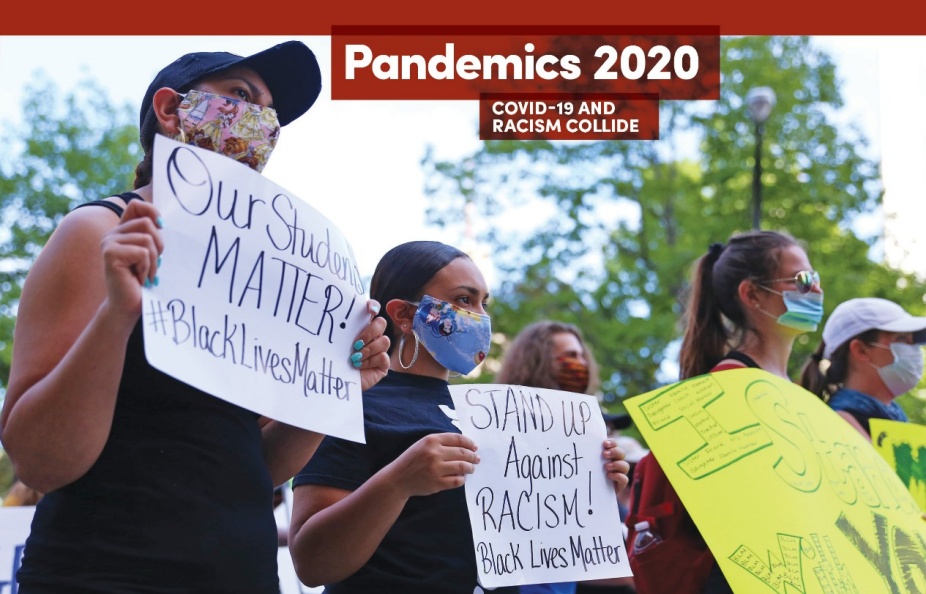
Protestors at a Buffalo rally for educators in downtown’s Niagara Square, June 9, 2020. They joined hundreds voicing their support for the Black Lives Matter movement. (WBFO Photo/Kyle S. Mackie)
UnexpectED
Pandemics 2020: COVID-19 and Racism Collide
BY MICHELLE KEARNS
At first, 2020 seemed like a straight-forward, normal year, new and full of promise. A presidential election lay ahead. The economy looked good: low interest rates and a rising stock market. The New York governor’s budget aimed for a middle-class tax cut and additional school aid. Buffalo’s renaissance continued with neighborhood rehabs, transformed downtown buildings and a reimagined waterfront.
At UB, research made news, enrollment grew. The Graduate School of Education looked forward to its 2022 move to South Campus, back to Foster Hall. UB had architects working on the refurbishment of the classic McKim, Mead & White building, where the Graduate School of Education began in 1931. Meetings were underway to plot this new, then still unnamed, magazine version of the .edu alumni newsletter.
Before spring broke, whatever we had in mind for 2020 changed.
A deadly new virus quietly swept the globe, infecting millions. Black men and women continued to be killed by police, a practice that would seem as if it, too, had raged on quietly, virus-like.
By March, a new reality dawned. Two pandemics emerged and soon collided. COVID-19 and racism. Shortly after midnight on Friday, March 13, Breonna Taylor, 26, a Black emergency medical technician, was shot dead at home in Louisville, Ky., in a police drug raid gone wrong. Hours later, President Trump declared the pandemic a national emergency. It would be the last day of in-person classes at UB and other places, including the Buffalo Public Schools.
Alarming news began its steady drum. On March 14, Gov. Andrew Cuomo announced the state’s first two virus deaths. The next week, New York had 3,437 cases. Then came business closings. Only those considered “essential”—hospitals, suppliers of food, and drink—could keep buildings open. Everyone else, including the people of GSE, went home to work by Zoom and Google Classroom. Day by day, news broadcasts were daunting and riveting. Social distancing rules. Mask wearing disagreements. Shortages of supplies and basics, like face masks and toilet paper and flour and yeast. Dr. Anthony Fauci’s sobering virus updates. Governor Cuomo’s daily briefings that reassured with their regularity.
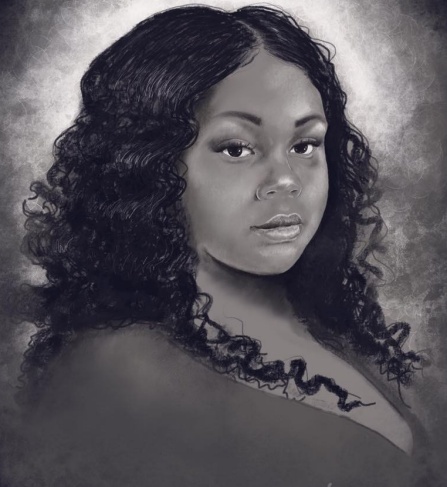
Illustration of Breonna Taylor by Jennifer Salucci
Without the usual things to do, an overwhelmed public came to focus on what, for some, had been easy to ignore: Habitual racism, white privilege, segregation. Protests popped up. Some escalated to mayhem.
The presidential election inched closer. Millions reassessed the American narrative with a new political lens.
In more than a century since the end of slavery, the pursuit of happiness, equality and justice, made famous in this nation’s founding 18th century documents were still not being applied to everyone in the 21st century. Breonna Taylor’s death was magnified by more Black killings. Ahmaud Marquez Arbery was shot running through his neighborhood. Dreasjon “Sean” Reed’s shooting by police livestreamed on Facebook. Then, explosively in May, a video of Officer Derek Chauvin’s deadly kneel on George Floyd’s neck.
For students of color, racism colored both pandemics. The disease’s disproportionate impact on their communities was coupled by the burdens of new social awareness and attention.
Along with all the other turbulence, the pandemic was cataclysmic for education. Parents scrambled when they couldn’t stay home to help with cyber classes. Those who were lucky enough to be in the house grappled with new home-school routines and virtual learning how-tos. Educators had to be nimble, rechart course plans and navigate foreign technology. Teaching students in person felt like a bygone, underappreciated privilege.
In a spring semester’s time, life for a generation transformed.
TIMELINE
The following timeline chronicles highlights of the “pandemics” and the actions they spurred among the educators, psychologists, data analysts and information scientists of the GSE community.
January
JAN. 11
■ China reports its first death from a new virus that researchers identified earlier as infecting dozen of people in Wuhan, a city of more than 11 million.
JAN. 20
■ U.S. and other countries confirm virus cases.
February
FEB. 21
■ Buffalo news channels 4 and 7 broadcast stories about Qinghua Chen, GSE PhD student and Shanghai native, who produced a video with greetings from 140 local people to cheer and support people in China struggling with COVID-19.
FEB. 23
■ Ahmaud Marquez Arbery, 25, an unarmed Black man, killed while jogging near Brunswick, Ga. Travis McMichael accused of the shooting after he, his father Gregory and William “Roddie” Bryan pursued Arbery.
March
MARCH 1
■ New York’s first diagnosed coronavirus case.
MARCH 3
■ The Centers for Disease Control lifts all restrictions on testing, allowing U.S. officials to approve widespread virus testing.
MARCH 10
■ New York orders the nation’s first virus “containment zone,” closing schools and gathering places in New Rochelle.
MARCH 13
■ President Trump declares the Covid-19 pandemic a national emergency and sends funding to states.

■ Breonna Taylor, 26, a Black emergency medical technician, is shot eight times by police who used a no-knock warrant in Louisville, Ky.
■ The last day of in-person classes at UB and other campuses, including the Buffalo Public Schools.
MARCH 14
■ Governor Cuomo announces the state’s first two coronavirus deaths.
MARCH 18
■ Gov. Cuomo signs an executive order mandating that employees work from home for all but essential businesses as New York counts 3,437 Covid-19 cases.
■ President Trump invokes the Defense Production Act to increase medical resources.
■ U.S.-Canada border closes.
■ GSE establishes Student Emergency Hardship Fund.
MARCH 22
■ Gov. Cuomo orders all nonessential businesses to close. The state officially goes on “PAUSE” (Policies that Assure Uniform Safety for Everyone).
■ The National Guard is deployed to the states hit hardest by the virus — California, New York and Washington.
MARCH 23
■ New York City surpasses 12,000 COVID-19 cases, 35 percent of U.S. total.

■ Raven Baxter (see story), a science education PhD student, produces, from home, “Wipe it Down,” a rap video about the virus and staying safe.

■ Information science PhD student Monica Rogers (see story) begins analyzing COVID-19 case data for her employer, the Tulsa Health Department.
MARCH 24

■ Gifted Math Program navigates pandemic and finishes with new digital tools (see story). With little notice, program directors, 10 teachers and 11 UB student assistants had to figure out how to continue classes for 280 seventh through 12th graders used to traveling from schools all over Western New York for advanced math lessons in Baldy Hall.
MARCH 26
■ Baxter’s “Wipe it Down” goes viral. Newscasters from New York City to Hawaii share the story.
March Timeline Stories
UB student crafts COVID-19 data models as government adapts to virus
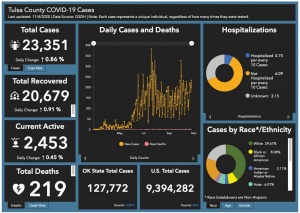
A screen shot from the Tulsa County Department of Health website, Nov. 4, 2020. The COVID-19 data were collected by information science doctoral student Monica Rogers, right.
Since the pandemic started, officials in Oklahoma have been turning to Monica Rogers, information science doctoral student, for analysis of COVID-19 throughout Tulsa County. This includes chronicling the rise and decline of the viral spread and discovering that cases dropped three to four weeks after the city of Tulsa mandated the wearing of face masks in public.
Rogers, recently promoted to division chief of data and technology for the Tulsa Health Department, has worked in information science for more than a decade. She enrolled at GSE in January of 2020 because of the PhD program’s flexibility and distance learning options, which allowed her to do her coursework from home in Oklahoma.
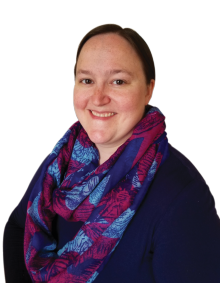
Doing her graduate studies while working full-time in a related field has been rewarding and illuminating. As she starts her last year of coursework, she is considering a dissertation research project about data visualization literacy to discover which formats help people better understand different kinds of data. Professionally, she translates data for people so they can have a better understanding of its meaning. For example, she has used her knowledge of virus data to advise school districts. She once suggested a district close schools, less than a month after opening because of high case and exposure numbers.
“It makes me grateful that so many people are invested and interested in the data and using the data to inform their decisions.”
Since the pandemic started, her job changed and her interest in her GSE studies of data and data visualization grew as she shifted from forecasting the prevalence of chronic conditions like heart disease and diabetes to monitoring COVID-19-related infections, hospitalizations and deaths. She now writes the talking points for news conference briefings and has presented data to a local school board weighing reopening. “It makes me grateful that so many people are invested and interested in the data and,” said Rogers, “using the data to inform their decisions.”
April
APRIL 1
■ To keep the GSE community connected while campus is closed, Dean Rosenblith launches weekly Zoom coffee meetings with students.
■ GSE alumna and psychologist Tawanna Gilford, PhD, shepherds the “Compassion Cart” project to help de-stress staff throughout the NYC Health and Hospital System’s Harlem Hospital campus, assessing emotional needs, offering solace, snacks, water and, once, flowering plants — 1,275 of them.
■ GSE teacher candidates work together with teacher mentors to figure out how to co-teach from home.
APRIL 3
■ CDC recommends that all citizens wear face masks.
APRIL 6
■ Stephanie Fredrick, assistant professor in counseling, school and educational psychology, reaches out to parents to alleviate virus worries with a Zoom seminar — “Answering Tough Kid Questions ...”
APRIL 15
■ Cuomo signs an executive order requiring face masks.
APRIL 17
■ News 4 Buffalo airs story about GSE PhD student Qinghua Chen: She raised more than $2,100, ordered 3,600 surgical-grade masks from China and then donated them to emergency responders and urgent care centers for children in Amherst, N.Y.
APRIL 24

■ Dean Rosenblith holds a roundtable discussion (see story) with fellow academic leaders about the pandemic’s impact on public education.
APRIL 27
■ Confirmed U.S. COVID-19 cases surpass 1 million.
April Timeline Stories
A Zoom roundtable: Adapting to higher ed’s new landscape

Getting classes and school operations to work well in a remote, cyber world was, and still is, intense, exhausting and inspiring. This spring, as the pandemic’s changes settled in, GSE deans, UB leaders and faculty took stock and adapted to the swiftly shifting reality, starting with the 10-day window for getting all instruction online after campus closed in March. Through Zoom meetings, they kept up to date, gained insights and marked progress. In one forum in April, Dean Suzanne Rosenblith shared her perspective on GSE’s experience with Barbara Ricotta, senior associate vice president for student life, and Jay Roorbach, EdM ’19, senior emergency planning coordinator.
For Rosenblith, the challenge was managing what felt like chaos by organizing, delegating, putting the academic mission first and helping alarmed students navigate the new normal. “We’ve had to be really nimble and it’s led to some pretty innovative thinking,” said Rosenblith. “I hope that stays with us permanently as part of the DNA of the university.”
The panel also talked about the silver linings. During new, virtual coffee meetings Rosenblith started hosting to catch up with students, she was pleased to hear this: With all of the increased communication during the pandemic, one online student felt more connected than ever.
“We can learn from this,” Rosenblith said. “If there’s a barrier, we just have to figure it out what that solution might be.”
May
MAY 3
■ Nina Pop, 28, a Black transgender woman, found dead, with multiple stab wounds, in her apartment in Sikeston, Mo. She was at least the 10th trans person to die by violence in the U.S. this year.
MAY 6
■ Dreasjon “Sean” Reed, 21, a Black man, fatally shot by Indianapolis police in an altercation streamed live on Facebook.
■ Sarah Robert, an associate professor and a specialist in school food politics, joins Seeding Resilience: A consortium of people and organizations getting food to people in need, that includes UB’s Food Lab policy research group.
MAY 8

■ GSE PhD student Quinghua Chen (see story) publishes “Born Artists,” an online exhibition, with artwork by children that she collected via WeChat, and reflecting pandemic-era life in seven countries — from China and the U.S. to Switzerland and Japan.
MAY 15
■ GSE holds its first ever virtual commencement ceremony for 326 master’s and 54 doctoral students.
■ The Trump administration announces Operation Warp Speed, a public–private partnership to accelerate COVID-19 vaccine development.
MAY 16

■ Early Childhood Research Center’s preschool shifts to remote learning (see story) with staff reading stories and leading yoga exercises via Facebook video posts.
MAY 22
■ Dean Rosenblith brings together faculty and staff on Zoom to discuss the pandemic-influenced changes at home and how gender affects parenting responsibilities.
MAY 25

■ Minneapolis police officer Derek Chauvin videotaped kneeling on the neck of George Floyd, 46, until he dies, as three other officers watch. The video goes viral.
■ Social media reignites #BlackLivesMatter movement in response to George Floyd’s death.
MAY 26

■ A video of Alexandra Schindel’s conversation (see story) with a Tapestry Charter School teacher answering third graders’ questions about her Galapagos journey and the science of ocean plastics pollution goes up on YouTube. The interview, the pandemic alternative to a classroom visit, connected to the students’ semester of water study.
■ Protests begin in the Minneapolis–St. Paul area following George Floyd’s killing.
MAY 27
■ Minneapolis protests turn violent as activists call for murder charges against the police officers involved in George Floyd’s death.
■ Tony McDade, 38, a Black transgender man, was fatally shot by a police officer in Tallahassee, Fla.
■ U.S. COVID-19 deaths surpass 100,000.
MAY 28
■ A state of emergency declared in the Twin Cities, with hundreds of National Guard soldiers deployed, as social justice protests spread nationwide.

■ Dean Rosenblith holds another Zoom session (see story) with staff and faculty to talk about George Floyd’s death and emerging racism and social justice concerns.
MAY 29
■ Minneapolis officer Derek Chauvin charged with third-degree murder and manslaughter in the death of George Floyd. High-profile protests began in Portland, Ore., in response to Floyd’s killing.
■ Portland Mayor Ted Wheeler declares state of emergency and imposes curfew as protests become violent.
■ Learning and Instruction Professor and Chair Julie Gorlewski’s “Endless Work, Endless Love: Teaching and Mothering During a Pandemic” publishes in Teachers College Record.
MAY 30
■ As riots and protests continue nationwide, curfews are set in Los Angeles, Philadelphia and Atlanta.
■ UB’s President Satish Tripathi releases a statement in response the police killings in Minneapolis, Atlanta and Louisville — “We mourn peacefully but not passively.”
■ Protests begin outside Buffalo’s City Hall in response George Floyd’s death.
May Timeline Stories
Pandemic solace—GSE PhD student
BY MICHELLE KEARNS
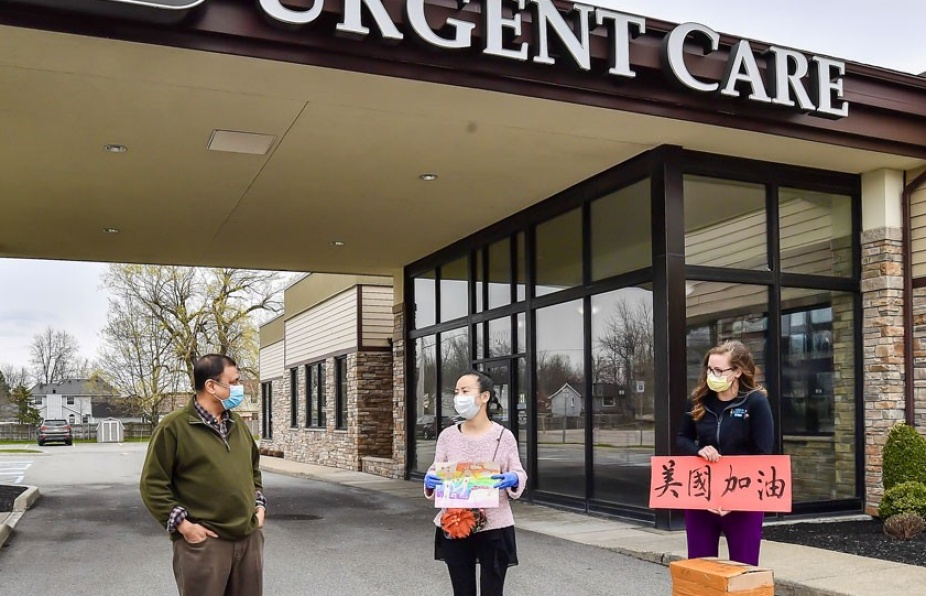
As news of virus outbreaks swept from China to the U.S. and around the world, GSE PhD student Qinghua Chen tried to help by launching a series of creative, collaborative projects. She started by making a video of local people speaking from UB’s North Campus and elsewhere to show support for people in China. Then she raised money to buy 3,600 face masks for emergency workers in Amherst, NY. Her latest effort is an online showcase of photos of art made at home by children around the world after schools closed.

Their work ranges from crayon drawings of nurses in face masks to sculpture and performance art, including a boat from recycled cans, a paper-mâché balloon egg and a yoga session with stuffed animals.
“For me, I’m playing the role of a global citizen,” said Chen, who is a Presidential Fellow studying early childhood education in GSE’s Curriculum, Instruction and Science of Learning PhD Program. “I just want to help a little bit.”
Chen’s online exhibition features 100 art pieces made by 60 children in seven countries, including her 5-year-old daughter Leonie. The project followed her volunteer work at the Amherst library branches, planning exhibitions of children’s art for hallway displays. After the pandemic forced the closing of the libraries, along with the show she organized about this year’s Chinese Year of the Rat, Chen moved online.
From her blog on the Chinese WeChat app, she asked families to contribute photos of art related to themes of school closings, play and fighting the virus. Submissions came in from the U.S., the U.K., Switzerland, Japan, China, Canada and Australia. Soon she intends to add new exhibits to her developing website.
“I call this art gallery ‘Born Artists,’” said Chen, a former finance reporter for a British news service and marketing and communications specialist at L’Oréal and Chanel in China. “I hope people can be inspired by these little artists and … be cheered up by their great art pieces.”
Her pandemic work at UB led to an unexpected career insight: How to work within a community.
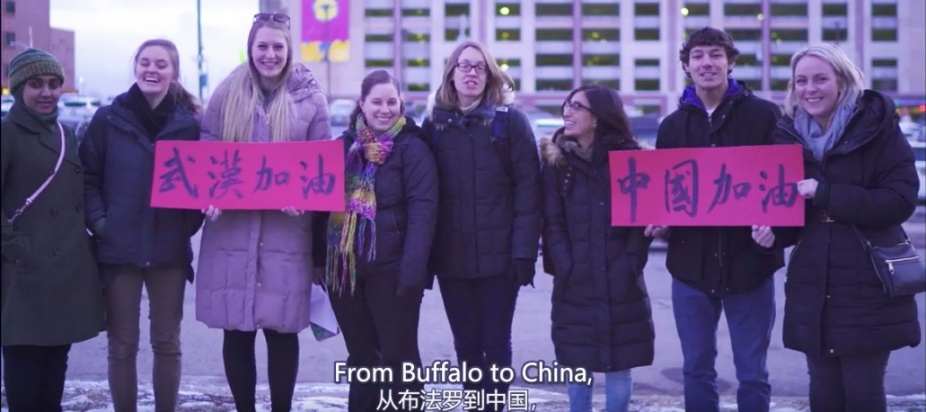
“I didn’t understand the full meaning of community until I came here,” said Chen. “I felt community was something that was vague and general and big,”
“I didn’t understand the full meaning of community until I came here,” said Chen. “I felt community was something that was vague and general and big.”
Now she includes herself in a series of small communities: At UB, among fellow Chinese students, within her daughter’s school and in her current neighborhood in Amherst. She worked with them all in recent months, feeling inspired by the willingness of people to pitch in on recent projects—with fundraising help, face-mask distribution, video making and the collection of art pieces.
Lately she’s been thinking of community in a new, more concrete way. It is: “Something solid that you do have a connection with … A place that I belong to, based on different dimensions and domains,” she said. “Now I know what a community means.”
Diversity forum: Understanding anti-Blackness and this time of change
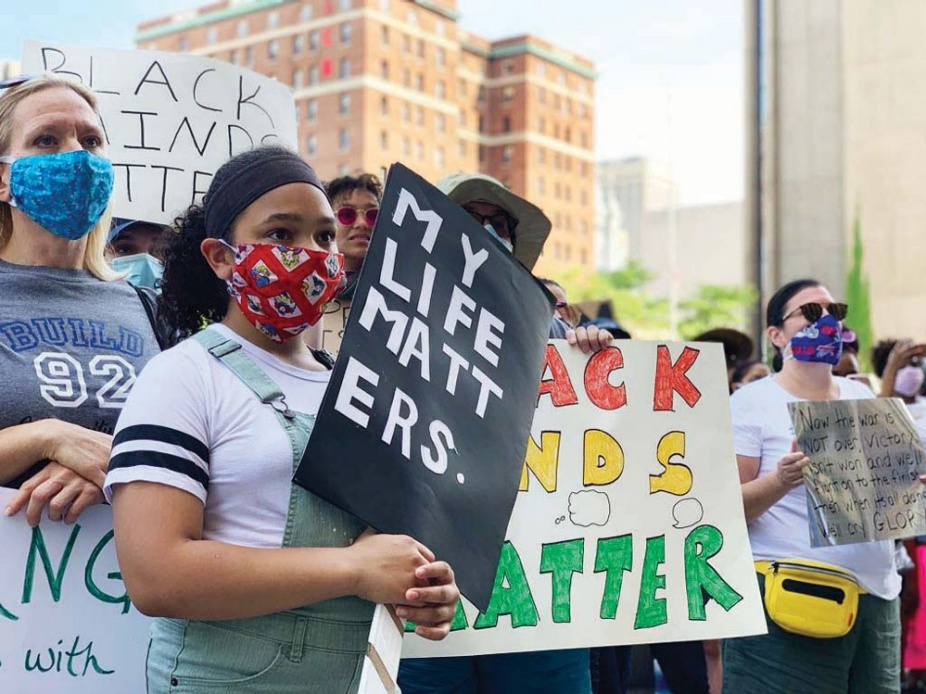
Protestors at a Buffalo rally for educators in downtown’s Niagara Square, June 9, 2020. They joined hundreds voicing their support for the Black Lives Matter movement. (WBFO Photo/Kyle S. Mackie)
As summer unfolded and news reports about the coronavirus overlapped with stories about race and the injustice, segregation and violence against people of color, GSE started a critical conversation with its community of students, staff and faculty. What was their experience with race and privilege in this time of civil unrest?
In a Zoom gathering, almost 60 people, mostly white, met to talk in what was the first step in planning forums for creating, and learning about change.
“I do believe, as a school of education, we have a particular role to play in this,” said Dean Suzanne Rosenblith. She then read the names of Black people killed by police this year and stopped for a silent tribute to Ahmaud Arbery, Breonna Taylor, Sean Reed, Tony McDade and George Floyd.
“Expect some discomfort,” said Raechele Pope, associate professor, associate dean for faculty and student affairs and chief diversity officer and moderator. “You really can’t grow without some challenge.”
Challenges ranged from the global to the personal. The dean had been thinking about the pain her students of color must feel at being dehumanized —for a lifetime—for the color of their skin.
Another professor said he was proud of the protestors’ bravery and willingness to go to the streets during the pandemic. Someone else spoke up, despairing that the killings continued in spite of it all. “What will it take to cause the change that we need?” she said.
Parents talked about their children. Pope worried about her Black son’s tendency to pause when someone asks him a question. If police stopped him, would they shoot rather than wait?
White parents were concerned about similar things, but noted they are not in the same situation because their children are not Black. A mother wondered at her own unwitting contribution to white supremacy. What about the safety of unarmed protestors and her sons, who worked in law enforcement and carried guns? “They’re out there in the protests and I, honestly, can’t watch them.”
As a Black mom said this year was an awakening for her and her son. As young teen, he didn’t understand why, a couple of years ago, she was so upset to see him run from the corner store where he bought something. Police, or someone else, might misunderstand his running and assume he was fleeing from a crime.
“Fast forward, in 2020, he’s now having a better understanding of why he’s unable to run,” she said. The bottom line: All kids should feel free to run. “I’m hurt,” she added, “and quite frankly disgusted with the way that things are being handled and where we are in 2020.”
For the white people participating in the conversation, the issues included abandoning their “culture of niceness” and its practice of avoiding difficult topics, like race. “To be white and to be cautious around race … means it’s hard for me to contribute to change,” said Amy Reynolds, a psychologist and professor in the counseling, school and educational psychology department “For me, it’s been a lifelong challenge to unlearn what I was taught.”
- In May, Dean Suzanne Rosenblith hosted a conversation for faculty and staff to share perspectives about gender roles and the dramatic changes at home, especially for parents.
- Early Childhood Research Center staff read stories and even led yoga class for little ones. The preschool’s Facebook page stayed updated with videos parents could share with their children.
- To help further, a new GSE webpage collected ideas, videos, links and resources being launched by professors, students and alumni: Open Educational Resources
June
JUNE 1
■ Dean Suzanne Rosenblith and Associate Dean Raechele Pope condemn racism with an email policy announcement: As an institution of public education, GSE has a responsibility to speak out.
■ President Trump threatens to deploy the military to quell riots. The National Guard and police clear peaceful protestors for a photo op of him with a Bible at St. John’s Church.
JUNE 2

■ People post single black squares on social media for Blackout Tuesday, a music industry-provoked protest against racism and police brutality.
JUNE 4
■ Buffalo police officers make national news when they keep moving forward after one of them shoves peaceful Niagara Square protestor Martin Gugino, 75, to the ground, causing serious injury.
JUNE 9
■ A protest rally on the steps of City Hall, one of a series in Buffalo, features educators and GSE alumna Tiffany Nyachae, PhD, an assistant professor of education at Penn State, who speaks about the importance of increasing faculty diversity.
JUNE 10
■ The U.S. counts more than 2 million COVID-19 cases.

■ GSE Professor Nathan Daun-Barnett publishes insights (see story) about potential positive outcomes from the COVID-19 pandemic.
JUNE 12
■ Protests in Atlanta follow the police killing of Rayshard Brooks, 27, in a Wendy’s parking lot.
■ GSE Professor Myles Faith’s research appears around the world with revelations that children with obesity were hurt by the pandemic’s stay-at-home rules with negative effects on diet, sleep and physical activity.
JUNE 13
■ Protesters burn down the Wendy’s where Rayshard Brooks died. Atlanta Police Chief Erika Shields resigns.
JUNE 17

■ UB President Tripathi announces a new President’s Advisory Council on Race, inviting Associate Dean Raechele Pope and PhD student Raven Baxter to serve (see story).
JUNE 19
■ The annual Juneteenth commemoration of the emancipation of enslaved people becomes a state holiday, as declared by Gov. Cuomo
June Timeline Stories
Improved graduation rates, less chronic absenteeism: Some good may come from COVID-19
BY DOUGLAS SITLER
There may be an educational upside to COVID-19. It’s true that school building shutdowns wrought havoc on lives in 2020 and interrupted school. The entire education system was disrupted by the pandemic–with students, teachers and families navigating unchartered territory.
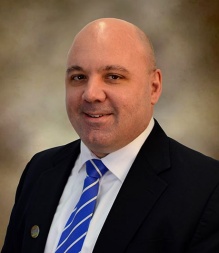
Yet, within this somber landscape, Nathan Daun-Barnett, an associate professor of higher education administration, found promising possibilities of good things that may come. There are at least four, by his count.
1. Graduation rates could rise
“We may see more students complete high school, particularly in high-need districts,” said Daun-Barnett. “One of the barriers for students to finish high school is the successful passage of Regents exams in core academic subjects. This year, New York State cancelled the exams and will waive the requirement under certain conditions, including that the student successfully pass the course. This is the reason we may see additional graduates this year.”
2. Lack of jobs could also provoke an increase in college enrollment
“Related to the first, we may see that more students consider college as a possibility because they have completed the high school credential. It is generally reported that more students are second-guessing their decisions. It is possible that we see overall declines, but it is also possible that students will find that their alternatives to college are limited. The job market is sluggish and going to college may seem a better alternative. This is often what we find during economic downturns but the psychology of a pandemic that has an uncertain time horizon is different.”
3. Online schooling could ease chronic absenteeism and help students with health issues
“We may find new ways to make education accessible to those that have chronic health conditions. We know that there are tremendous health disparities along lines of race and class. And we also know that chronic absenteeism is an important predictor of poor performance in school,” said Daun-Barnett. “We make assumptions about why students are not in school, but at least for some, health conditions play an important role. Now that we are figuring out how to deliver education virtually, we may find that it can be a vehicle for those who cannot be in school as regularly. We still have more work to do to refine these practices, but we are closer now because so many more educators have been exposed to these strategies.”
4. More effective online teaching
“We may also find that we become better at delivering distance education now that all students and teachers have operated in that environment. We have heard from online students that they feel more engaged by faculty now that all classes are online because we have had to be more intentional about how we provide a high-quality education when students and faculty cannot be in the classroom …These are lessons we can and should apply to all of our distance programs,” said Daun-Barnett. “To be clear, at this point, the in-person experience is better than what we provide in a virtual environment, but we may find improvements in these practices because so many instructors have had to shift their teaching to a virtual environment.”
UB president creates advisory council to focus on race
Two from GSE join new president’s committee to foster change
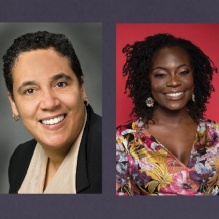
Pictured left, Raechele L. Pope, an associate professor of educational leadership and policy, chief diversity officer and associate dean of faculty and student affairs. Picture right, Raven Baxter, a science education PhD student.
UB President Satish Tripathi responded to calls for change in this unprecedented time by charging a new committee, which includes a GSE associate dean, with guiding university efforts to adapt and change, evaluating curriculum, finding ways to recruit more Black faculty and encouraging community conversations about race and racism.
The new 16-member President’s Advisory Council on Race formed in July, with temporary summer input from Raven Baxter, a science education PhD student specializing in STEM communication, and continuing work on faculty recruitment with Raechele L. Pope, an associate professor of educational leadership and policy, chief diversity officer and associate dean of faculty and student affairs.
“Let’s look at our organizations—our campus in this case—from top to bottom and figure out what we need to do, what we need to do differently, and what are some of the best practices that already exist,” said Pope speaking about the need to deeply examine university practices in a June story by WBFO, NPR’s local station.
In announcing the new university-wide committee, Tripathi said he was responding to three historic moments affecting Black and Hispanic communities: the global pandemic that has taken more than 200,000 American lives and counting, an economic crisis that left more than 20 million people out of work and frustration, anxiety and despair following centuries of intolerance and oppression of the Black community.
“Across the country, protests have brought hundreds of thousands of people into the streets … Their outrage has amplified the call to collectively address injustice, racism and violence. Doing so requires nothing less than meaningful structural change,” Tripathi wrote in his email announcement. “More than ever before, UB should serve as a bastion of hope and a community of action compelled by the greater good.”
During her work with the curriculum committee, Baxter was excited by the possibility of a course about anti-racism for students beginning their academic careers. “If you have that knowledge and that awareness before you go out into the world,” she said, “that will help to curb some of these oppressive cultures that we’re seeing today.”
July
JULY 2, 3 & 4
■ Raging protests in Portland, Ore. become increasingly violent.
JULY 7
■ A research commentary by GSE Clinical Assistant Professor Tiffany Karalis Noel publishes in Social Sciences & Humanities Open with an analysis of the stigmatizing impact of disease names with geographic references.
JULY 20
■ Forbes magazine includes an interview with GSE’s Raechele Pope, associate professor and chief diversity officer, in its story, “What Colleges’ Leaders Can Do To Address Racial Justice.”
JULY 24
■ Federal forces deploy to quell protests in Portland, Ore., where their unmarked cars and officers in camouflage, without clear identification badges, generate a national outcry.
JULY 29
■ Oregon Governor Kate Brown and Vice President Mike Pence agree to a phased withdrawal of federal officers from Portland.
August
AUG. 10
■ GSE announces the establishment of the Equity, Diversity, Justice and Inclusion fund (see story) for school initiatives promoting diversity and inclusion.
AUG. 23
■ Violent protests break out in Kenosha, Wisc., following the police shooting of Jacob Blake, 29.
■ The FDA grants emergency authorization for antibody-rich blood plasma treatments for COVID-19 hospital patients.
AUG. 25
■ Two protesting the shooting of Jacob Blake were fatally shot in Kenosha, Wisc. Kyle Rittenhouse, 17, of Antioch, Ill., accused of allegedly using an AR-15-style rifle in the shooting.
AUG. 29
■ Thousands of people gather at the Lincoln Memorial in Washington, D.C. for the Commitment March, organized by the Rev. Al Sharpton and with Martin Luther King III, in support of Black civil rights.
■ GSE holds its first virtual new student orientation and 433 register to attend.
August Timeline Stories
EDJI fund launches
Bringing in perspective, training and insight from people seeped in the work of transforming racism, anti-Blackness and institutional injustice was the reason for creating the new GSE reserve fund for Equity, Diversity and Justice Initiatives. The monies will help pay for guest speakers, workshops, consultants, professional development and other initiatives that promote diversity and inclusion.
“Like many schools and colleges of education, GSE is thinking carefully, robustly, and comprehensively about our sustained response to social unrest,” Dean Suzanne Rosenblith wrote to explain the philosophy behind the fund. “Our approach will be to attend to racism, inequality, educational injustice on multiple fronts – curricular, programmatic, policy, and community engagement.”
New committee takes on social justice
The new Equity, Diversity, Justice, and Inclusion Committee will help to implement GSE’s new 2025 Comprehensive Plan and develop new programs and policies focused on diversity and inclusion. The team, which includes faculty from all departments and is led by Raechele Pope, associate dean of faculty and student affairs, chief diversity officer, and associate professor of educational leadership and policy, began its assignment this summer, planning and executing September’s Teach-In. They now have shifted to reviewing curriculum and considering how to increase underrepresented groups of faculty, staff and students.
The work includes developing a proposal, to be put to GSE for a vote, defining the purpose and function of the new standing committee.
Pope is keen to evaluate and find approaches, including how advising, mentoring and pedagogy can address racial disparity. “We’ve got an opportunity,” she said. “There are students who are saying that ‘My experience as a Black student here is very different than the white student …’ How do we fix that?”
Hard work is ahead, she said, but the current momentum is the beginning of fundamental change.
September
SEPT. 1

■ Uniting GSE through a shared reading project (see story). As professors leading classes know, reading books together brings people together in conversation and collaboration. This fall, Dean Suzanne Rosenblith took that approach with staff, faculty and students by launching a GSE-wide social justice reading project with departments choosing books that related to their work.
SEPT. 2
■ Protests breakout in Rochester, N.Y., following the release of disturbing police body-camera footage of the fatal March arrest of Daniel Prude, 41, an unarmed Black man having a psychotic drug episode.

■ Fortune Magazine includes GSE PhD student Raven Baxter, 27, in the health care group of a special expanded version of its annual 40 Under 40 list of young innovators.
SEPT. 3 & 4

■ GSE cancels classes and hosts the “Make Good Trouble Now Teach-In” (see story) about race and equity for faculty, students and staff. The two-day event features five national experts and 82 breakout discussion sessions. Faculty, staff, alumni and community members highlight topics ranging from book club reading to Black career navigation and teaching about race in majority white schools.
SEPT. 11
■ GSE’s Equity, Diversity, Justice and Inclusion webpage launches and features a strategic plan with diversity goals.
SEPT. 18
■ Supreme Court Justice Ruth Bader Ginsburg dies.
SEPT. 22
■ The U.S. COVID-19 death toll passes 200,000.
September Timeline Stories
Group reading about racism and social change
As professors leading classes know, reading books together brings people together in conversation and collaboration. This fall, Dean Suzanne Rosenblith took that approach with staff, faculty and students by launching a GSE-wide social justice reading project with departments choosing books that related to their work.
“I tend to be interested in fostering community and shared experiences–with COVID, and people feeling more estranged from one another, it became even more important,” said Rosenblith. “We are a learning community and when confronted with significant social issues, one way to address them is join together in a common learning activity.”
GSE’s fall reading list and department choices:

“How to Be an Antiracist” by Ibram X. Kendi
Chosen by the Counseling, School and Educational Psychology Department, the Dean’s and Admissions off¡ces and the Communications and Marketing team.

“Multiplication is for White People: Raising Expectations for Other People’s Children” by Lisa Delpit
Chosen by the Department of Counseling, School and Educational Psychology.

“The Racial Healing Handbook: Practical Activities to Help You Challenge Privilege, Confront Systemic Racism, and Engage in Collective Healing” by Anneliese Singh
Chosen by the Department of Counseling, School and Educational Psychology.

“The Privileged Poor: How Elite Colleges Are Failing Disadvantaged Students” by Anthony Abraham Jack
Chosen by the Department of Educational Leadership and Policy.

“We Want to Do More Than Survive: Abolitionist Teaching and the Pursuit of Educational Freedom,” by Bettina Love
Chosen by the Department of Learning and Instruction.

“White Fragility: Why It’s So Hard for White People to Talk About Racism” by Robin DiAngleo
Chosen by the Department of Information Science.
A call to action
BY MARCENE ROBINSON
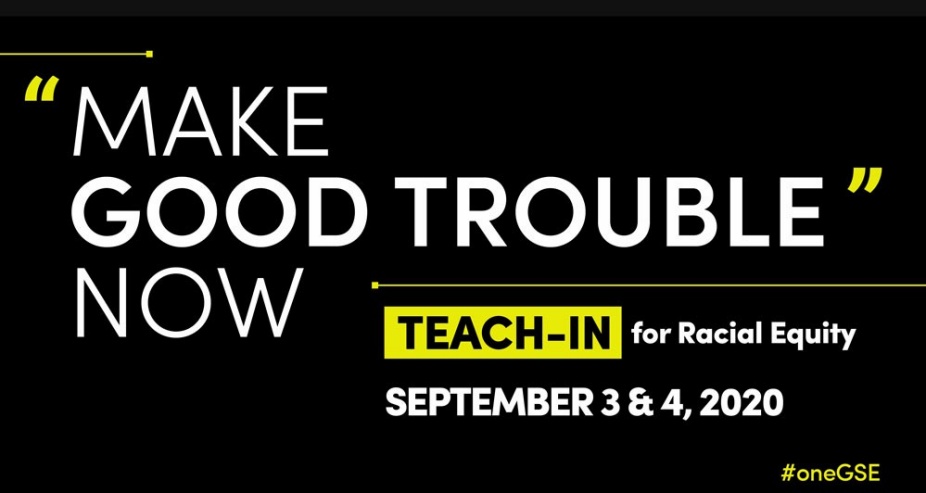
GSE started the academic year by canceling classes and activities for students, faculty and staff to make time for a teach-in style forum rooted in the anti-war movement of the 1960s: “Make Good Trouble Now: Teach-In for Racial Equity.” For two days, five keynote speakers and leaders in 82 breakout sessions explored issues gripping the nation: the murder of Black people by police, institutional racism, internalized oppression and privilege, educational equality and routes toward change.
“This just isn’t done. Some may think we are lucky that we can afford to shut down normal operations. The fact of the matter is, we can’t afford not to. It’s simply that critical,” said event chair Raechele Pope, associate dean of faculty and student affairs, and chief diversity officer. “In the midst of two global pandemics — COVID-19 and racism — along with a global fiscal crisis, we are witnessing community activism and calls for systemic and structural change that are not going to go away.”
The virtual event, held Sept. 3-4, deployed the “teach-in” format, modeled on 1960s-era educational activism. Faculty, staff, and students listened and asked questions via Zoom and learned about the impact of racial injustice, particularly in education. Keynote speeches included “We Gon’ Be Alright, But That Ain’t Alright: Abolitionist Teaching and the Pursuit of Educational Freedom” by award-winning author Bettina Love.

More than 80 breakout sessions were scholars, alumni and community partners who discussed a range of themes—from anti-racist reading groups to the barriers challenges and successes of professional Black women and how students from a white rural community used digital storytelling tools to explore the meaning of Martin Luther King Day. The two days ended with a town hall conversation about how to incorporate insights at GSE.
“Change is both an individual and collective responsibility,” said Dean Suzanne Rosenblith. “As an institution of higher education, we continue this work through the radical act of teaching and learning.”
The discussions were part of a larger national dialogue about racism sparked by the killing of George Floyd in Minneapolis in May, and reignited by news of more deaths, like the September shooting of Jacob Blake in Kenosha, Wis.
“GSE recognizes that it cannot make good on its mission and vision, or on its commitment to equity, diversity, justice and inclusion, without ensuring that all faculty, staff and students have a more fundamental understanding of the systematic violence against Black people and the role that education has played and continues to play in perpetuating systems of oppression,” said Rosenblith.
Plans for change
BY MICHELLE KEARNS
As the two-day Teach-In came to a close, people started talking about what it meant. That happened first at the final town hall session led by Dean Suzanne Rosenblith and Raechele Pope, associate dean of faculty and student affairs, and chief diversity officer.
In the days that followed, there was more conversation in smaller groups.
People said they were grateful that a tough topic was addressed. Speaking freely about the “elephant” of racism in the room was cathartic. It was also awkward and uncomfortable to figure out what to say— about racism, micro-aggressions and injustice of the racist U.S. systems that Black people are subjected to and that white people are protected from.
And, in part, feeling uncomfortable was exactly the point.
“Discomfort and conflict are part of being anti-racist,” said Rosenblith as she spoke during the town-hall meeting at the end of the conference’s second day. “Creating a community and culture where discomfort and conflict are the norm is necessary to making anti-racism part of our learning norms and it amplifies the idea that anti-racism is a daily practice.”
She then highlighted a comment from keynote speaker, psychologist and diversity consultant Carlton Green: “If you’re not making mistakes while doing anti-racist work, you’re not doing anti-racist work.”
Ahead, Rosenblith said GSE will be looking for ways to support students who may have returned to campus changed or reeling — from a social and political awakening, economic distress, COVID or stress about and fear of the next instance of racial violence. For PhD student Chazz Robinson, the two days of lectures and conversations about inclusion, awareness and justice were gratifying. It was heartening to see GSE take this lead on combating the racism that shaped some of his own academic career.
“Through all the madness of the pandemic … the Teach-In was wonderful,” he said, adding that Bettina Love’s direct and sometimes funny talk about advocating for awareness and change was his favorite. He has used this time to consider his own research interest in finding ways for academia to support Black students like himself from poor working-class backgrounds. “We have systems and policies in place that don’t see people as people … I just hope that I get to be a part of this change… I feel optimistic that change can happen.”
October
OCT. 1
■ President Donald Trump and first lady Melania Trump test positive for COVID-19.
OCT. 7
■ Derek Chauvin, former police officer charged with the murder of George Floyd, posts bail.
OCT. 16
■ The U.S. surpasses eight million cases of COVID-19.
OCT. 24
■ Cases of COVID-19 rise in 43 states with single-day records set in 7 of those states.
2020 carries on … This timeline captured some of the year’s major events, the overlap and collision of the virus spread, racism, police killings, social justice outcry, educators’ response and the changed world we now find ourselves in. We couldn’t include everything. When this magazine went to press, Joe Biden emerged as the president-elect, President Trump did not concede, some Republicans encouraged his move to battle the results in court, COVID-19 cases rose more sharply than in the spring. The world confronted a second wave as news broke of a promising new vaccine. This nation and this university now confront a complicated aftermath. Questions about race, equity and the tumult of 2020 remain. The answers lie ahead.
